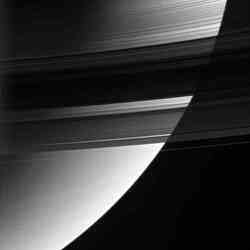
Saturn’s rings from their unlit side. Image credit: NASA/JPL/SSI Click to enlarge
This magnificent view looks down upon, and partially through, Saturn’s rings from their unlit side.
The densest part of the rings occults the bright globe of Saturn. Scientists can use observations like this to determine precisely the concentration of ring particles.
When the bright source is the signals coming from the spacecraft, the technique is called a ‘radio occultation.’ In a radio occultation measurement, a signal is beamed toward Earth from Cassini’s 4-meter-wide (13-foot) high-gain antenna. Researchers on Earth receive the signal as the spacecraft passes behind the rings. The reduction in Cassini’s radio signal tells researchers how densely packed the ring particles are. Scientists can also learn about the size distributions of the particles from occultations.
As an added (but tiny) bonus, Saturn’s moon Atlas (32 kilometers, or 20 miles across) is visible as a dark speck against the planet, just outside the A ring.
The image was taken in visible red light with the Cassini spacecraft wide-angle camera on Aug. 2, 2005, at a distance of approximately 617,000 kilometers (383,000 miles) from Saturn. The image scale is 37 kilometers (23 miles) per pixel.
The Cassini-Huygens mission is a cooperative project of NASA, the European Space Agency and the Italian Space Agency. The Jet Propulsion Laboratory, a division of the California Institute of Technology in Pasadena, manages the mission for NASA’s Science Mission Directorate, Washington, D.C. The Cassini orbiter and its two onboard cameras were designed, developed and assembled at JPL. The imaging operations center is based at the Space Science Institute in Boulder, Colo.
For more information about the Cassini-Huygens mission visit http://saturn.jpl.nasa.gov . The Cassini imaging team homepage is at http://ciclops.org .
Original Source: NASA/JPL/SSI News Release
